Native American dreamcatchers are more than just decorative pieces; they hold deep cultural significance.
These intricate and symbolic items have a rich history rooted in tradition and spirituality.
Let’s explore the fascinating world of dreamcatchers and uncover the meaningful stories and beliefs that surround these iconic symbols.
1. Origin of Dreamcatchers

Dreamcatchers originated with the Ojibwe people. They were initially crafted to protect children from nightmares.
The circular design, reminiscent of a spider’s web, is believed to capture bad dreams. Over time, dreamcatchers gained popularity among various Native American tribes, becoming widely recognized symbols.
2. Symbolic Circle

The circle in dreamcatchers represents the circle of life. It signifies how forces, like the sun and moon, move across the sky daily.
Within this circle, the web traps negative dreams, allowing only good thoughts to pass through, symbolizing protection and unity.
3. Cultural Exchange

Dreamcatchers spread from the Ojibwe to other tribes through trade and cultural exchange. Each tribe added unique elements, reflecting their traditions.
This sharing fostered unity and understanding among tribes, contributing to a broader appreciation of dreamcatchers’ cultural significance across communities.
4. Materials Used

Traditional dreamcatchers are made from natural materials like willow hoops, sinew, and feathers. These elements are chosen for their connection to nature.
Feathers, often from sacred birds, symbolize breath or air, essential for life. This natural composition enhances the dreamcatcher’s spiritual significance.
5. Dreamcatchers in Modern Culture

Dreamcatchers have found a place in modern culture. They’ve become popular decorative items, featured in homes and fashion.
While visually appealing, it’s important to respect their cultural roots. Many Indigenous artists continue to craft dreamcatchers, emphasizing authenticity and cultural integrity.
6. Spiritual Meanings

Each component of a dreamcatcher holds spiritual meanings. Feathers symbolize freedom and wisdom, while beads represent the spider that wove the web.
This spiritual symbolism underscores the dreamcatcher’s role in safeguarding individuals from negative energies, fostering a deeper connection to one’s spirituality.
7. Dreamcatchers in Art

Artists have drawn inspiration from dreamcatchers, incorporating them into various art forms. These pieces celebrate cultural heritage while experimenting with color and design.
By blending traditional and contemporary styles, artists honor dreamcatchers, making them a canvas for cultural storytelling and expression.
8. Dreamcatchers for Healing

Beyond dream protection, dreamcatchers are used in healing rituals. They serve as focal points in ceremonies, promoting mental and emotional well-being.
The soothing presence of a dreamcatcher encourages introspection, helping individuals find peace and balance through spiritual practices and communal support.
9. Dreamcatchers in Education

Dreamcatchers are educational tools, teaching children about Native American culture. Through crafting and storytelling, they learn about symbolism and tradition.
This educational use fosters cultural appreciation and understanding, ensuring that the significance of dreamcatchers is preserved for future generations.
10. Ethical Considerations

When engaging with dreamcatchers, it’s essential to consider cultural appropriation. Supporting Indigenous artisans ensures respect for their traditions.
Ethical engagement means recognizing the cultural significance and fostering appreciation rather than mere commercialization, preserving the integrity of this important cultural symbol.

